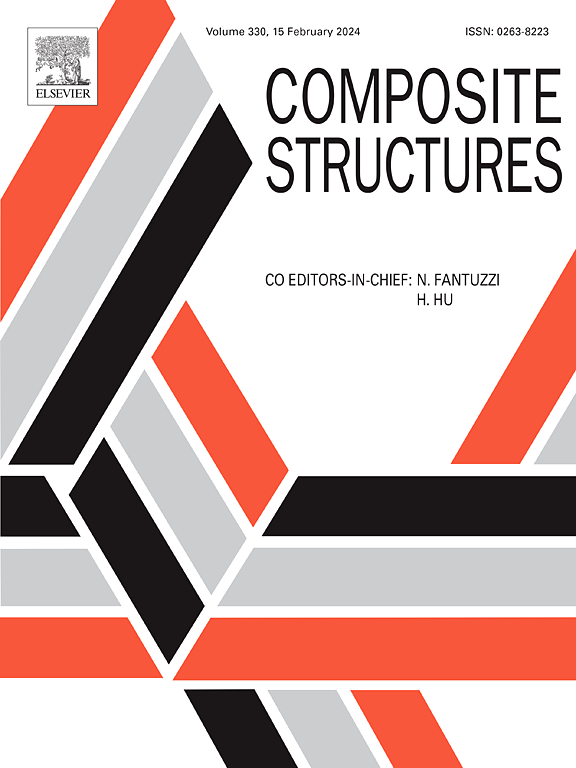生物炭增强过硫酸盐水泥的压缩性能和机理
IF 6.3
2区 材料科学
Q1 MATERIALS SCIENCE, COMPOSITES
引用次数: 0
摘要
将生物炭(BC)掺入过硫酸盐水泥(SSC)中是提高其低碳性能的一种很有前途的方法。本研究通过抗压强度、声发射、数字图像相关和扫描电镜测试,探讨bc改性SSC的抗压行为和机制。结果表明,2 % BC的最优抗压强度提高11.0 %,并建立了强度预测模型。表观裂纹分析表明,bc改性的SSC具有多种裂纹模式。含有2 % BC的SSC的横向应变比未改性的SSC大1.2倍。微裂纹监测表明,经2 % BC改性的SSC的声发射信号幅值超出了纯SSC膏体的35 ~ 60 dB范围,由于BC的断裂,声发射信号幅值达到60 ~ 80 dB。此外,2 % BC的加入使SSC复合材料中的剪切裂纹比例增加到44.1% %,这主要是由于BC联锁引起的位错效应。显微组织观察表明,BC在界面过渡区容易诱发裂纹。在最佳剂量下,BC使基体致密化,并通过纵向劈裂和横向断裂显著增强能量耗散。因此,适当添加BC可以显著提高SSC复合材料的抗压开裂性能。本文章由计算机程序翻译,如有差异,请以英文原文为准。
Compressive behaviour and mechanisms of supersulfated cement enhanced by biochar
The incorporation of biochar (BC) into supersulfated cement (SSC) offers a promising approach to enhance its low-carbon performance. This study explores the compressive behavior and mechanisms of BC-modified SSC through compressive strength, acoustic emission, digital image correlation, and scanning electron microscopy tests. The results reveal that 2 % BC optimally increases compressive strength by 11.0 %, and a strength prediction model is proposed. Apparent crack analysis demonstrates that BC-modified SSC exhibits diverse cracking patterns. The transverse strain of SSC containing 2 % BC is 1.2 times greater than unmodified SSC. Microcrack monitoring indicates that the AE signal amplitude of SSC modified with 2 % BC extends beyond the original range of 35–60 dB observed in pure SSC paste, reaching 60–80 dB due to the fracture of BC. Furthermore, the inclusion of 2 % BC increases the proportion of shear cracks in SSC composites to 44.1 %, primarily attributed to the dislocation effect induced by BC interlocking. Microstructure observations show that BC tends to induce cracking in interfacial transition zone. At the optimal dosage, BC densifies the matrix and significantly enhances energy dissipation through longitudinal splitting and transverse fracture. Thus, the appropriate incorporation of BC can markedly improve the compressive cracking resistance of SSC composites.
求助全文
通过发布文献求助,成功后即可免费获取论文全文。
去求助
来源期刊

Composite Structures
工程技术-材料科学:复合
CiteScore
12.00
自引率
12.70%
发文量
1246
审稿时长
78 days
期刊介绍:
The past few decades have seen outstanding advances in the use of composite materials in structural applications. There can be little doubt that, within engineering circles, composites have revolutionised traditional design concepts and made possible an unparalleled range of new and exciting possibilities as viable materials for construction. Composite Structures, an International Journal, disseminates knowledge between users, manufacturers, designers and researchers involved in structures or structural components manufactured using composite materials.
The journal publishes papers which contribute to knowledge in the use of composite materials in engineering structures. Papers deal with design, research and development studies, experimental investigations, theoretical analysis and fabrication techniques relevant to the application of composites in load-bearing components for assemblies, ranging from individual components such as plates and shells to complete composite structures.
 求助内容:
求助内容: 应助结果提醒方式:
应助结果提醒方式:


